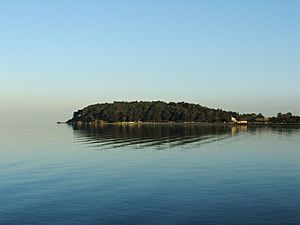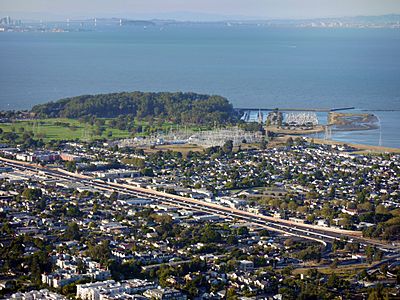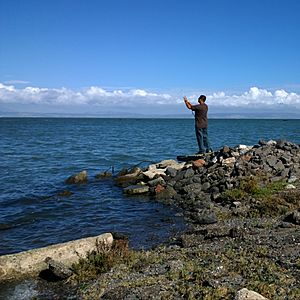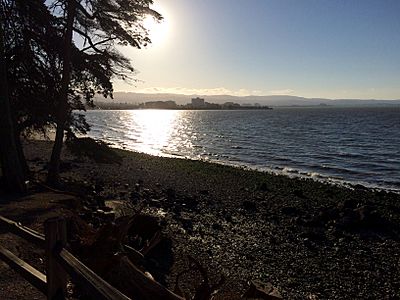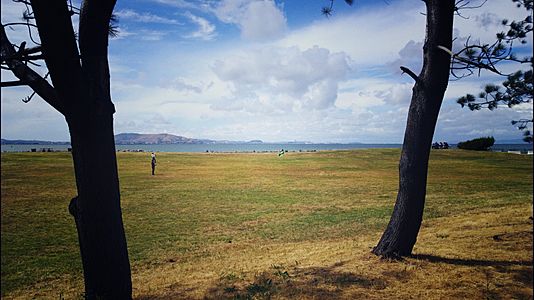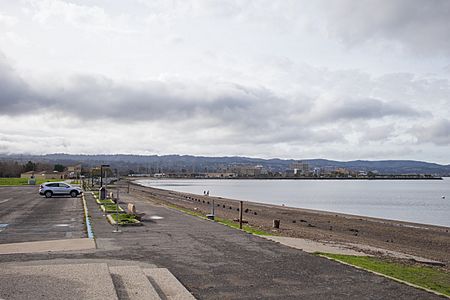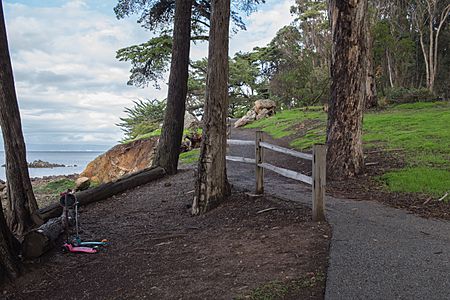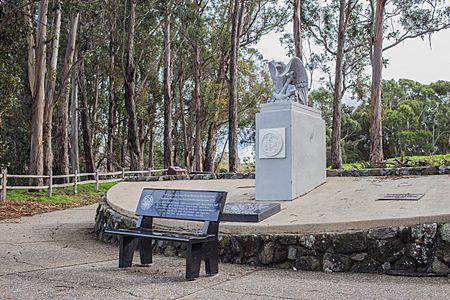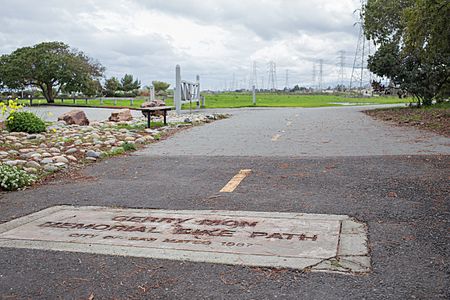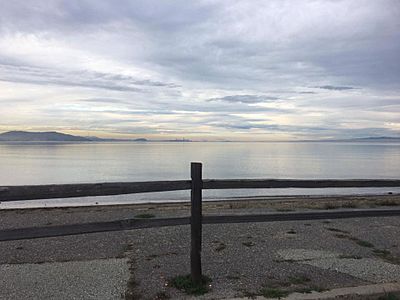Coyote Point Recreation Area facts for kids
Quick facts for kids Coyote Point Recreation Area |
|
|---|---|
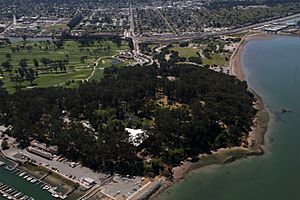
Coyote Point from the air. Peninsula Avenue retreats into the center background after crossing the Bayshore Freeway (US 101), which runs from left to right in the upper portion of the picture. The marina, at lower left, runs almost directly north-south. Beyond the trees, in the upper left, is the adjoining Poplar Creek Golf Course.
|
|
| Lua error in Module:Location_map at line 420: attempt to index field 'wikibase' (a nil value). | |
| Type | Parkland, woodland, museum & zoo |
| Location | San Mateo County, California, USA |
| Area | 670 acres (270 ha) |
| Created | 1962 |
| Operated by | San Mateo County, California |
| Open | All year |
Coyote Point Recreation Area is a large park in San Mateo County, California, United States. It covers about 670-acre (270 ha) of land. This park is located right on San Francisco Bay, south of the San Francisco International Airport. It sits between the cities of Burlingame and San Mateo.
The park's unique point, covered with eucalyptus trees, is easy to spot from airplanes flying into San Francisco International Airport. It's a great spot for watching planes take off and land. It's also a popular place for birdwatching, as many different birds visit the bay area.
Contents
Park History
Early Days of Coyote Point
Coyote Point was once an island in San Francisco Bay. A marsh connected it to the mainland. Native Americans likely used the point for special events or meals. This is because shell mounds, which are piles of shells from seafood, have been found there.
Spanish and Mexican Times
Coyote Point was part of lands owned by Spain, then Mexico. The land was later given to Coyetano Arenas, which is probably how the point got its name. The Arenas family sold it to a company, and then to the Howard family. The Howard family owned the land until 1942.
In the late 1800s, the Howard family built a pier at Coyote Point. They used it to load lumber onto ships. They also turned the marsh into land for dairy cows. In 1880, they built a bathhouse and a swimming pool on the beach. They also planted many trees, like Eucalyptus, Cypress, and Pine.
Pacific City Amusement Park
In July 1922, a fun amusement park called "Pacific City" opened at Coyote Point. It covered about 90 acres (36 ha) of land along the beach. People called it the "Coney Island of the West" because it was so exciting.
The park had a beach with sand brought in by trucks. It also featured a boardwalk, a playground for kids, a scenic railway, a merry-go-round, and a Ferris wheel. There was a dancing hall and many places to buy food. Even though it was very popular, a fire destroyed part of the park during its second year. It never opened for a third season. Strong winds and dirty bay water were also reasons for its closure. You can still find the carousel and a miniature train from the park at the San Francisco Zoo today!
Training School and College
In 1942, the United States government bought 10 acres (4.0 ha) of land at Coyote Point. They built a training school there for Merchant Marine Cadets. These cadets were training to work on ships during World War II. The school opened in August 1942 and could train over 500 cadets.
After the war, in 1946, the College of San Mateo bought the buildings. This became the college's campus until 1962. That's when San Mateo County bought the land to create the park we know today.
Park Activities
Coyote Point Recreation Area has many fun things to do! You can find lots of trails for walking and bicycling. Parts of the famous San Francisco Bay Trail run through the park. A big bicycle race called the Tour de Peninsula also starts and ends here.
The park has many picnic spots, perfect for a family outing. There are also larger picnic areas you can reserve for bigger groups. Other facilities include the Captains House Conference Facility, a pistol and rifle range, and the Coyote Point Marina. Don't forget the awesome Magic Mountain Playground, which is a favorite for younger visitors!
CuriOdyssey
CuriOdyssey is a special place inside Coyote Point Park. It used to be called the Coyote Point Museum for Environmental Education. It's a hands-on science museum and a zoo for native animals. You can find it at 1651 Coyote Point Drive in San Mateo, California.
- Science Exhibits: The main area has many hands-on science exhibits. Kids and families can explore and learn about natural things up close.
- Wildlife Habitats: The zoo part has 25 natural-looking homes for over 50 animals. These animals are native to California and cannot be released into the wild. You can see animals like a bobcat, river otter, snakes, golden eagles, and raccoons.
- Aviary: This is a large, walk-through area for birds, covering about 4,000-square-foot (370 m2). You can walk among more than a dozen native California birds that also cannot be released.
- Invertebrate Corner: This section features different native invertebrates. These include a California blond tarantula and black widow spider.
- Gardens: The gardens cover about 1.3 acres (0.53 ha) and have many different plants. Some are native to California. There's a hummingbird garden, a butterfly habitat, and a garden showing plants used by Native Californians.
Gallery
-
Coyote Point is covered in eucalyptus trees
-
View from Coyote Point facing Burlingame
Images for kids


